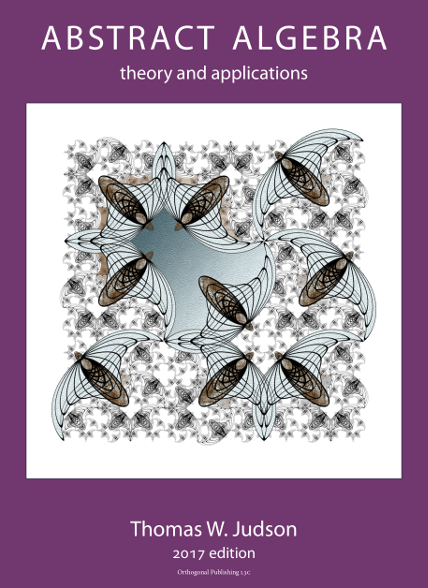Subsection1From the Instructor
This site contains a "remixed" edition of Thomas Judson's Abstract Algebra: Theory and Applications, selecting and rearranging topics to align with Bridgewater State University's MATH 301 Abstract Algebra I course. Judson's complete text, available to read and download for free, is available at http://abstract.ups.edu.
The selection and arrangement of topics in this site aligns chapter-for-chapter with Joseph Gallian's Contemporary Abstract Algebra (9th edition), one of the most widely-read introductory texts on abstract algebra. Math majors planning on advanced study will in particular find Gallian's text well worth the investment. Gallian maintains a webpage of resources for his text at http://www.d.umn.edu/~jgallian/, some of which are interspersed throughout this site as well. You might recognize one of the vocalists in the infamous a cappella video linked on Gallian's site.
Students are advised to draw inspiration from both authors to fill out their understanding of abstract algebra. You might find that each fills in explanations that the other does not, and presents concepts in ways that complement one another. This is very much a feature and not a bug -- the ultimate goal is that you use both authors' perspectives (and your instructor's, and your classmates') to build an understanding that is uniquely yours. Taking notes on everything you read and watch, and cherishing those notes, is a good first step. Conversing with classmates here in the margins of the text, and combining forces with them to solve problems and discover proofs both in and outside of the classroom, is the next.
Abstract algebra is truly a subject full of beauty but, perhaps equally importantly to the mathematics major, also revelation. The material in this course is intended to lay bare the assumptions and specificity with which our understanding of mathematics and algebra typically develop over the first twenty-odd years of our life, to reveal the "bigger picture." If your high-school algebra course was about studying the structure of a great oak tree, abstract algebra is about studying the physiological processes that make that tree grow, develop and shed leaves, and respire oxygen into the environment: all the "how does it work?" questions about the tree. But it's also about zooming out to see that tree as only one example in a whole forest of trees of all kinds -- many that resemble the oak tree you've studied, but others which do not: these are the "what else is there?" questions that abstract algebra seeks to ask and answer.
I was, in the beginning, quite a reluctant student of abstract algebra: my undergraduate program gave me the option of taking a full year of either abstract algebra or real analysis, and I opted for the latter (which was, frankly, the less popular choice among my fellow students). It wasn't until I had to dive into the subject as a second-year graduate student and, really, much later when I had to teach the subject myself, that I came to fully appreciate the way in which abstract algebra changes the lens through which mathematics can be viewed. It broadens perspectives, forms far-flung connections, and builds very rich questions around relatively simple structures. It empowers the mathematical mind in critical and durable ways.
I hope this course gives you some of the sense of mystery, beauty, and revelation that I felt when it was new to me.
Matthew SalomoneBridgewater, Massachusetts 2018
